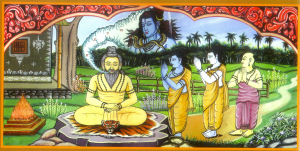Vyakarana Vedanga (व्याकरणवेदाङ्गम्)
| This article needs editing.
Add and improvise the content from reliable sources. |
Vyakarana (Samskrit: व्याकरणम्) or grammar, one of the important topics in the shad vedangas, is the foundation of language and communication in the evolutionary history of human beings. In the tradition of vyakarana, one can see the origin of analysis tracing back to Vedas. There are innumerable references to language elements, structure and nature in classical literature. Evidence shows that the terminology used for language analysis has its origin in the Vedas.
Introduction
The philosophy of language evolved by the schools of Vyakarana and Mimasa, is the outcome of elaboration of the suggestions found in the Vedas. The divine nature of speech, the creative and illuminative power of the word and the different levels of speech are the main doctrines which formed the philosophy of language in Bharatiya shastras. Of the six vedangas, the ancillary disciplines of the Vedas, Siksha (pronunciation), Vyakarana (grammar) and Nirukta are directly connected with the Vedas.
Every system of thought and the various darshana schools had to consider language at some stage or other and each one had given attention to the ultimate question concerning the relation between the word and reality. Language had both outer empirical and inner metaphysical dimensions. Panini and Patanjali while elaborating on technical and grammatical aspects of human speech also discussed the divine nature of Vak and the metaphysical qualities of language. Shabda has been directly identified with the language of Vedas as Shabda Brahman and divine Vak has been considered as the seed of creation. The Brhadaranyaka Upanishad has equates speech with Brahman.
Origin and History of Vyakarana
It is indisputable that language and literature of Bharatavarsha began with the Vedas. In Rigveda (also in Atharvaveda, Taittriya Aranyaka and Shatapatha Brahmana) we come across the four fold division of Vak (वाक्) an important aspect of Vyakarana.[1]
चत्वारि वाक्परिमिता पदानि तानि विदुर्ब्राह्मणा ये मनीषिणः ।
गुहा त्रीणि निहिता नेङ्गयन्ति तुरीयं वाचो मनुष्या वदन्ति ॥४५॥ (Rig. Veda. 1.164.45)
Gopathabrahmana of Atharvaveda mentions many terms that we use in vyakarana even today.
ओंकारं पृच्छामः। को धातुः। किं प्रातिपदिकम्। किं नामाख्यातम्। किं लिङ्गम्। किं वचनम्। का विभक्तिः। कः प्रत्ययः। कः स्वर उपसर्गो निपातः। किं वै व्याकरणम्। को विकारः। को विकारी। कतिमात्रः। कतिवर्णः। कत्यक्षरः। कतिपदः। कः संयोगः। किं स्थानानुप्रदानकरणं। (Gopa. Brah. 1.1.24)[2]
Meaning: Let us analyse Omkara, what is the dhatu? what is pratipadika? what is nama and akhyata? what is lingam ? what is vibhakti ? what is pratyaya? what is svara, upasarga, nipata? what is vyakarana? what is vikara? what is vikari and how many matras? how many varnas? how many aksharas? how many pada-s? what is samyoga? what is staana-naada-anupradana and anukaranam?
Apart from Gopatha Brahmana, Maitrayana samhita and Aitareya Brahmana also discusses different vibhaktis.
References
- ↑ Subramanya Sharma. V. M. (2012) Ph.D Thesis: The Notion of Word in Vakyapadiyam. Hyderabad : University of Hyderabad
- ↑ Gopatha Brahmana (Purvabhaga)

